
The Khajuraho Group of Monuments are a group of Hindu and Jain temples in Chhatarpur district, Madhya Pradesh, India, about 175 kilometres southeast of Jhansi. They are a UNESCO World Heritage Site. The temples are famous for their nagara-style architectural symbolism and their erotic sculptures.

Ellora is a UNESCO World Heritage Site located in the Aurangabad district of Maharashtra, India. It is one of the largest rock-cut Hindu temple cave complexes in the world, featuring Buddhist and Jain monuments with artwork dating from the period 600–1000 CE. Cave 16 features the largest single monolithic rock excavation in the world, the Kailash temple, a chariot-shaped monument dedicated to Lord Shiva. The Kailash temple excavation also features sculptures depicting the gods, goddesses found in Hinduism as well as relief panels summarizing the two major Hindu Epics.

Pattadakal, also called Paṭṭadakallu or Raktapura, is a complex of 7th and 8th century CE Hindu and Jain temples in northern Karnataka (India). Located on the west bank of the Mallaprabha River in Bagalakote district, this UNESCO World Heritage Site is 14 miles (23 km) from Badami and about 6 miles (9.7 km) from Aihole, both of which are historically significant centres of Chalukya monuments. The monument is a protected site under Indian law and is managed by the Archaeological Survey of India (ASI).

The Dilwara Temples or Delvada Temples are a group of svetambara Jain temples located about 2+1⁄2 kilometres from the Mount Abu settlement in Sirohi District, Rajasthan's only hill station. The earliest were built by Vimal Shah and supposedly designed or at least financed by Vastupala, Jain minister of Dholka. They date between the 11th and 16th centuries, forming some of the most famous monuments in the style of Māru-Gurjara architecture, famous for their use of a very pure white marble and intricate marble carvings. They are managed by Seth Shri Kalyanji Anandji Pedhi, Sirohi and are a pilgrimage place for Jains, and a significant general tourist attraction. Although Jains built many temples at other places in Rajasthan, the Dilwara temples are believed to be the most impressive.

Sabarkantha district is one of the 33 districts of Gujarat state of India and is located in the northeastern part of the state. The administrative headquarters of the district are located in Himatnagar.

Idar is a town in Sabarkantha district, Gujarat, India. It is known for the manufacture of handmade wooden toys, tiles, its temples and various beautiful architectural monuments on its hills, and its historical background. Idar is at the southern end of the Aravalli Range.

Aihole, also referred to as Aivalli, Ahivolal or Aryapura, is a historic site of ancient and medieval era Buddhist, Hindu and Jain monuments in Karnataka, India that dates from the sixth century through the twelfth century CE. Most of the surviving monuments at the site date from the 7th to 10th centuries. Located around an eponymous small village surrounded by farmlands and sandstone hills, Aihole is a major archaeological site featuring over one hundred and twenty stone and cave temples spread along the Malaprabha river valley, in Bagalakote district.Hunagunda Taluk Distance 35km

Taranga is a Jain pilgrimage center near Kheralu in Mehsana district, Gujarat, India, with two compounds of Jain temples that are important examples of the Māru-Gurjara style of architecture. The Ajitnatha temple, was constructed in 1161 by the Chaulukya king Kumarapala, under the advice of his teacher, Acharya Hemachandra. Both the main sects of Jainism are represented, with adjoining walled compounds: the Svetambara compound consists of 14 temples in all, and there are also five Digambara-affiliated temples at Taranga hill.

The Badami cave temples are a complex of Hindu and Jain cave temples located in Badami, a town in the Bagalkot district in northern part of Karnataka, India. The caves are important examples of Indian rock-cut architecture, especially Badami Chalukya architecture, and the earliest date from the 6th century. Badami is a modern name and was previously known as Vataapinagara, the capital of the early Chalukya dynasty, which ruled much of Karnataka from the 6th to the 8th century. Badami is situated on the west bank of a man-made lake ringed by an earthen wall with stone steps; it is surrounded on the north and south by forts built in later times.
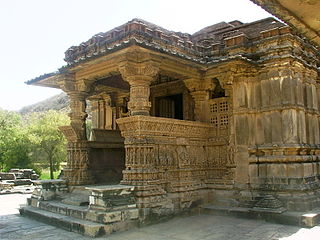
The architecture of the Indian state of Rajasthan has usually been a regional variant of the style of Indian architecture prevailing in north India at the time. Rajasthan is especially notable for the forts and palaces of the many Rajput rulers, which are popular tourist attractions.
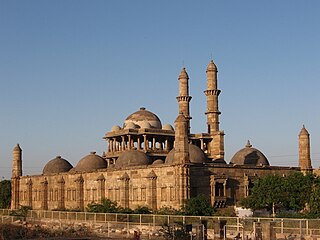
Jami Masjid in Champaner, Gujarat state, western India, is part of the Champaner-Pavagadh Archaeological Park, a UNESCO World Heritage Site, and is among the 114 monuments there which are listed by the Baroda Heritage Trust. It is located about 150 feet (46 m) east of the city walls (Jahdnpandh), near the east gate.

There are eleven different types of buildings at the UNESCO-protected Champaner-Pavagadh Archaeological Park in Gujarat, India, including mosques, temples, granaries, tombs, wells, walls, and terraces. The monuments are situated at the foot of and around the Pavagadh Hill. The Baroda Heritage Trust lists 114 monuments in the area, of which only 39 are maintained by the Archaeological Survey of India, due to limited funding. The Forest Department owns 94% of the land here, while the temple trusts and other sectarian establishments provide facilities for boarding and lodging to pilgrims and tourists. On the southern side near the foot of the hill some dilapidated houses and the foundations of Jain temples can also be seen.
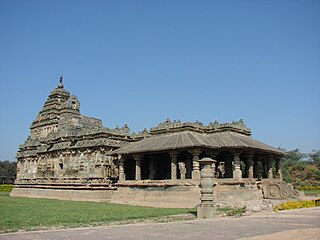
The Brahma Jinalaya, sometimes called as the Greater Jain Temple of Lakkundi, is an early 11th-century Mahavira temple in Lakkundi, Gadag District of Karnataka state, India. The temple is attributed to Attiyabbe, the wife of the local governor Dandanayaka Nagadeva. It faces east, has a mukhamandapa, a gudhamandapa and its sanctum is covered by a sur-temple style vimana superstructure. The temple is notable for its reliefs depicting Jaina artwork, statues of the Tirthankaras and the two Hindu statues of Brahma and Saraswati inside its inner mandapa.

Manwal is a town in Udhampur district of Jammu and Kashmir, India. It lies 28 km (17 mi) away from the district headquarters of Udhampur.

The Khed-Roda Group of Monuments include eighth-ninth century dated seven Hindu temples built during Gurjara-Pratihara or Rashtrakuta period. It also include a reservoir (Kund) and a stepwell. They are located between Raisingpura (Roda) and Khed Chandarani villages, 18 km from Himmatnagar in Sabarkantha district of Gujarat, India. It is located on the bank of the seasonal stream which merges Hathmati river downstream.

Polo forest, also known as Vijaynagar forest, is a dry mixed deciduous forest near Abhapur village in Vijaynagar Taluka, Sabarkantha district, Gujarat, India. It is located at the foothills of the Aravalli range and on the banks of perennial Harnav river, spread over the area of 400 square kilometres.
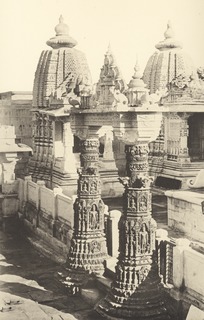
The Mahavira Jain temple is built in Osian of Jodhpur District, Rajasthan. The temple is an important pilgrimage of the Oswal Jain community. This temple is the oldest surviving Jain temple in Western India and was built during the reign of Mahārāja Śrī Vatsarāja of Imperial Pratihāras. The temple is visited by both Jain and Hindu.
Panchasara Parshwanath temple is a Jain temple located in Patan, Gujarat.
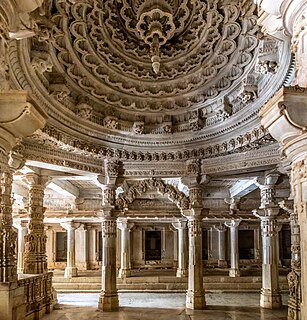
The Kumbharia Jain temples is a group of five Jain temples in the Kumbhariya, Banaskantha district in Gujarat, India. Constructed from 1062 to 1231 CE during the reign of the Chaulukya dynasty, they are noted for their elaborate architecture.

Ambapuram cave temple or Nedumbi Basadi is a rock-cut Jain cave temple in Ambapuram village near Vijayawada in the state of Andhra Pradesh.
























